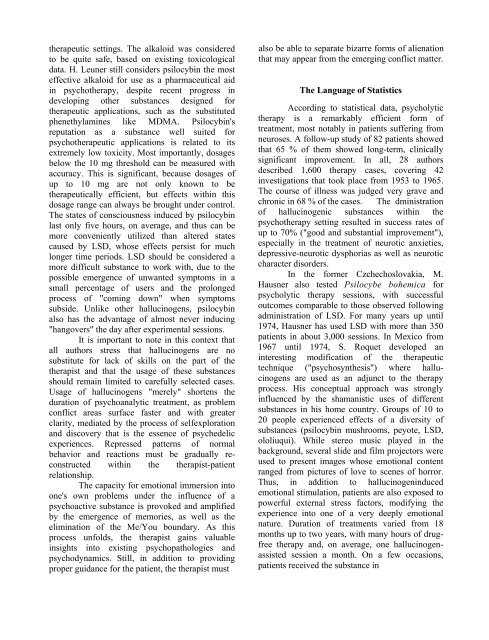Jochen Gartz - Magic Mushrooms Around the ... - preterhuman.net
Jochen Gartz - Magic Mushrooms Around the ... - preterhuman.net
Jochen Gartz - Magic Mushrooms Around the ... - preterhuman.net
Create successful ePaper yourself
Turn your PDF publications into a flip-book with our unique Google optimized e-Paper software.
<strong>the</strong>rapeutic settings. The alkaloid was considered<br />
to be quite safe, based on existing toxicological<br />
data. H. Leuner still considers psilocybin <strong>the</strong> most<br />
effective alkaloid for use as a pharmaceutical aid<br />
in psycho<strong>the</strong>rapy, despite recent progress in<br />
developing o<strong>the</strong>r substances designed for<br />
<strong>the</strong>rapeutic applications, such as <strong>the</strong> substituted<br />
phe<strong>net</strong>hylamines like MDMA. Psilocybin's<br />
reputation as a substance well suited for<br />
psycho<strong>the</strong>rapeutic applications is related to its<br />
extremely low toxicity. Most importantly, dosages<br />
below <strong>the</strong> 10 mg threshold can be measured with<br />
accuracy. This is significant, because dosages of<br />
up to 10 mg are not only known to be<br />
<strong>the</strong>rapeutically efficient, but effects within this<br />
dosage range can always be brought under control.<br />
The states of consciousness induced by psilocybin<br />
last only five hours, on average, and thus can be<br />
more conveniently utilized than altered states<br />
caused by LSD, whose effects persist for much<br />
longer time periods. LSD should be considered a<br />
more difficult substance to work with, due to <strong>the</strong><br />
possible emergence of unwanted symptoms in a<br />
small percentage of users and <strong>the</strong> prolonged<br />
process of "coming down" when symptoms<br />
subside. Unlike o<strong>the</strong>r hallucinogens, psilocybin<br />
also has <strong>the</strong> advantage of almost never inducing<br />
"hangovers" <strong>the</strong> day after experimental sessions.<br />
It is important to note in this context that<br />
all authors stress that hallucinogens are no<br />
substitute for lack of skills on <strong>the</strong> part of <strong>the</strong><br />
<strong>the</strong>rapist and that <strong>the</strong> usage of <strong>the</strong>se substances<br />
should remain limited to carefully selected cases.<br />
Usage of hallucinogens "merely" shortens <strong>the</strong><br />
duration of psychoanalytic treatment, as problem<br />
conflict areas surface faster and with greater<br />
clarity, mediated by <strong>the</strong> process of selfexploration<br />
and discovery that is <strong>the</strong> essence of psychedelic<br />
experiences. Repressed patterns of normal<br />
behavior and reactions must be gradually reconstructed<br />
within <strong>the</strong> <strong>the</strong>rapist-patient<br />
relationship.<br />
The capacity for emotional immersion into<br />
one's own problems under <strong>the</strong> influence of a<br />
psychoactive substance is provoked and amplified<br />
by <strong>the</strong> emergence of memories, as well as <strong>the</strong><br />
elimination of <strong>the</strong> Me/You boundary. As this<br />
process unfolds, <strong>the</strong> <strong>the</strong>rapist gains valuable<br />
insights into existing psychopathologies and<br />
psychodynamics. Still, in addition to providing<br />
proper guidance for <strong>the</strong> patient, <strong>the</strong> <strong>the</strong>rapist must<br />
also be able to separate bizarre forms of alienation<br />
that may appear from <strong>the</strong> emerging conflict matter.<br />
The Language of Statistics<br />
According to statistical data, psycholytic<br />
<strong>the</strong>rapy is a remarkably efficient form of<br />
treatment, most notably in patients suffering from<br />
neuroses. A follow-up study of 82 patients showed<br />
that 65 % of <strong>the</strong>m showed long-term, clinically<br />
significant improvement. In all, 28 authors<br />
described 1,600 <strong>the</strong>rapy cases, covering 42<br />
investigations that took place from 1953 to 1965.<br />
The course of illness was judged very grave and<br />
chronic in 68 % of <strong>the</strong> cases. The dministration<br />
of hallucinogenic substances within <strong>the</strong><br />
psycho<strong>the</strong>rapy setting resulted in success rates of<br />
up to 70% ("good and substantial improvement"),<br />
especially in <strong>the</strong> treatment of neurotic anxieties,<br />
depressive-neurotic dysphorias as well as neurotic<br />
character disorders.<br />
In <strong>the</strong> former Czchechoslovakia, M.<br />
Hausner also tested Psilocybe bohemica for<br />
psycholytic <strong>the</strong>rapy sessions, with successful<br />
outcomes comparable to those observed following<br />
administration of LSD. For many years up until<br />
1974, Hausner has used LSD with more than 350<br />
patients in about 3,000 sessions. In Mexico from<br />
1967 until 1974, S. Roquet developed an<br />
interesting modification of <strong>the</strong> <strong>the</strong>rapeutic<br />
technique ("psychosyn<strong>the</strong>sis") where hallucinogens<br />
are used as an adjunct to <strong>the</strong> <strong>the</strong>rapy<br />
process. His conceptual approach was strongly<br />
influenced by <strong>the</strong> shamanistic uses of different<br />
substances in his home country. Groups of 10 to<br />
20 people experienced effects of a diversity of<br />
substances (psilocybin mushrooms, peyote, LSD,<br />
ololiuqui). While stereo music played in <strong>the</strong><br />
background, several slide and film projectors were<br />
used to present images whose emotional content<br />
ranged from pictures of love to scenes of horror.<br />
Thus, in addition to hallucinogeninduced<br />
emotional stimulation, patients are also exposed to<br />
powerful external stress factors, modifying <strong>the</strong><br />
experience into one of a very deeply emotional<br />
nature. Duration of treatments varied from 18<br />
months up to two years, with many hours of drugfree<br />
<strong>the</strong>rapy and, on average, one hallucinogenassisted<br />
session a month. On a few occasions,<br />
patients received <strong>the</strong> substance in








![The Big Lie 9-11 and Government Complicity in Mass Murder [PDF]](https://img.yumpu.com/50957077/1/190x245/the-big-lie-9-11-and-government-complicity-in-mass-murder-pdf.jpg?quality=85)








